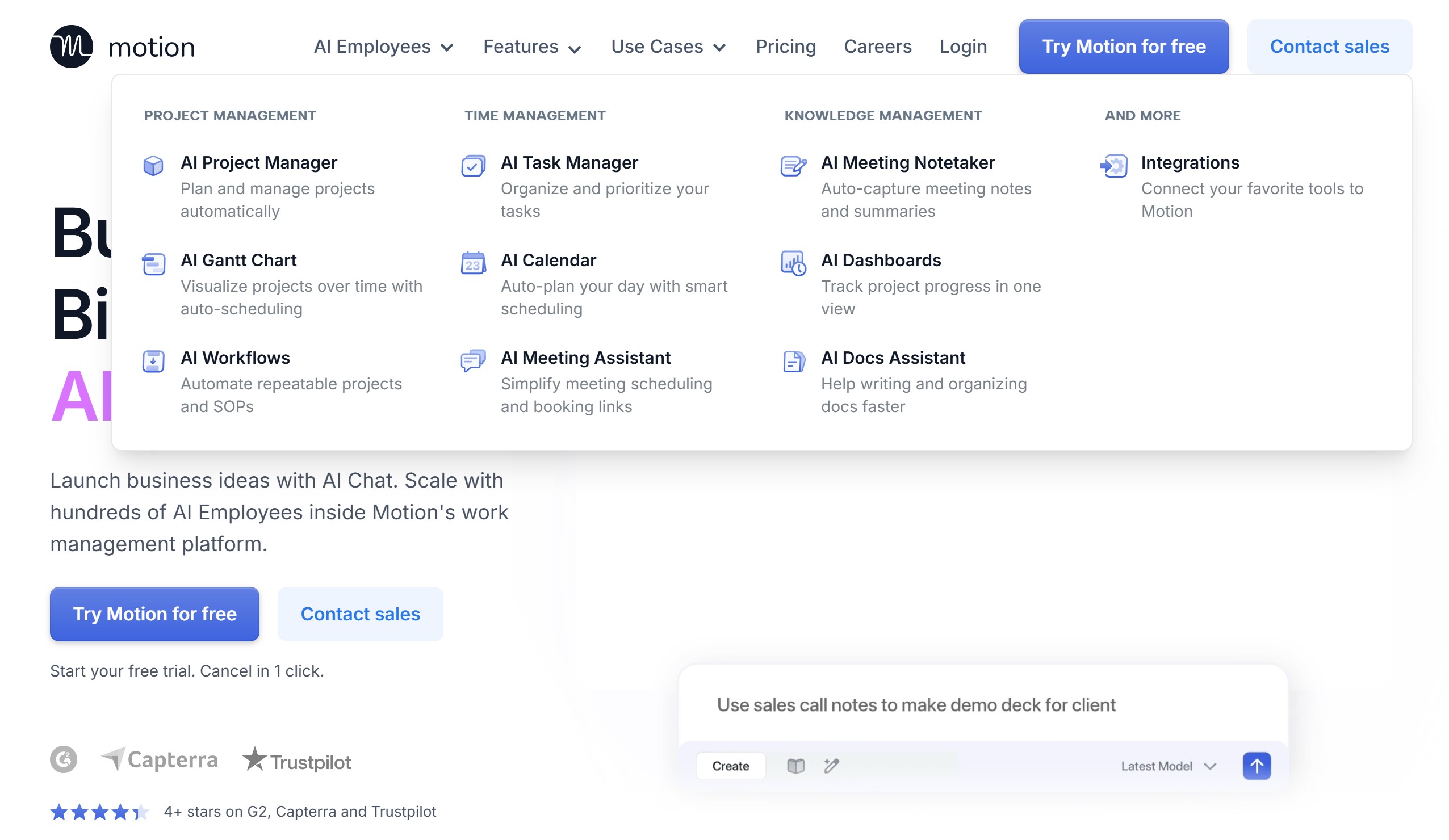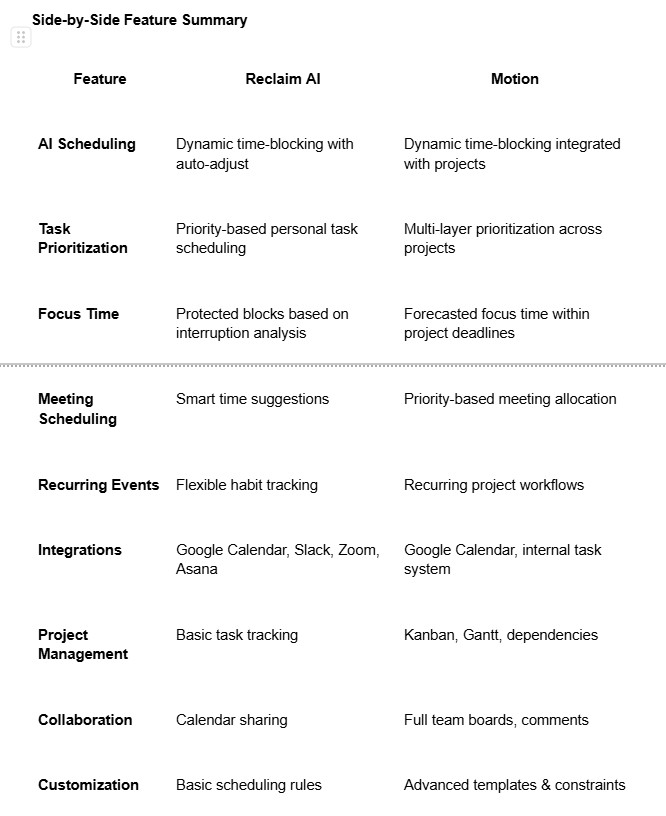Reclaim AI vs Motion (2025): Features, Pricing & AI Scheduling Tool Comparison
.jpg)
Introduction
In 2025, the competition between Reclaim AI vs Motion has become one of the most discussed topics in the AI scheduling tool space. Both platforms are designed to take the stress out of calendar management, task planning, and productivity optimization, but their approaches differ significantly.
Reclaim AI focuses on smart time-blocking, automatically finding the best times for tasks, habits, and meetings while adapting to schedule changes in real time. Motion, on the other hand, brands itself as an all-in-one AI daily planner, merging task lists, calendar scheduling, and project management into a single interface.
The rise of AI-powered productivity tools has shifted the way individuals and teams work, and this comparison aims to help you choose the best fit based on features, pricing, user experience, and unique capabilities.
Whether you’re a freelancer seeking better focus time, a manager balancing team availability, or a remote worker aiming to automate scheduling, understanding the strengths and trade-offs of Motion vs Reclaim AI will ensure you make a decision that enhances your workflow and saves valuable time.
1. Overview: Reclaim AI and Motion

Reclaim AI was founded with the mission to help professionals protect their time through intelligent calendar management. The platform uses AI to automatically prioritize and schedule tasks, habits, and recurring events without manual drag-and-drop adjustments. It integrates with Google Calendar and other productivity apps to dynamically shift items based on changing priorities. For individuals, this means better focus time allocation; for teams, it improves coordination without endless back-and-forth messaging.
Motion, launched with a broader ambition, combines AI scheduling with task and project management in a single workspace. Its core strength lies in replacing multiple tools — your calendar, to-do list, and Kanban board — with one AI-driven system. Motion also excels at re-prioritizing tasks in real time and breaking down large projects into smaller, scheduled blocks.
Both platforms are rooted in the philosophy of reducing decision fatigue. Instead of manually deciding what to work on next, these tools automate the process based on your goals and deadlines. The main difference is that Reclaim AI’s primary focus remains calendar-first scheduling, while Motion takes an all-in-one project and time management approach.
In terms of audience, Reclaim AI is often favored by knowledge workers, executives, and teams that already use robust project management systems but want smarter time allocation. Motion appeals to small businesses, startups, and freelancers who prefer to manage tasks and calendars in one integrated platform.
In short, while both tools are leaders in the AI-powered productivity tool market, your choice may come down to whether you want a specialized AI scheduling assistant (Reclaim AI) or an all-in-one AI productivity workspace (Motion).
2. Feature-by-Feature Comparison

The Reclaim AI vs Motion comparison begins with their shared foundation: both tools aim to use artificial intelligence to optimize your calendar, automate task scheduling, and reduce manual time management. However, the way they achieve this differs significantly.
AI Scheduling & Dynamic Time Blocking
Reclaim AI excels in dynamic time-blocking that automatically adjusts your calendar based on shifting priorities. If a meeting gets rescheduled, tasks and habits automatically move to the next best available slot. Motion also offers dynamic time-blocking but integrates this directly with its task management system, ensuring all planned work is aligned with project timelines.
Task Prioritization
Reclaim AI lets you assign priority levels to tasks, and the AI schedules them accordingly. It’s particularly strong for individual workload management without overwhelming the user. Motion’s prioritization is deeper, allowing tasks to be ranked within projects, across teams, and even linked to dependencies that shift the entire schedule if one milestone changes.
Focus Time Optimization
Reclaim AI automatically creates focus blocks by identifying the least interrupted periods in your day. These blocks can be protected to avoid meeting clashes. Motion also provides focus time but layers in a productivity forecast, showing how much of your high-priority work can realistically be completed in the week ahead.
Meeting Scheduling
Reclaim AI’s meeting scheduling is lightweight but smart. It finds mutually available times with team members and suggests optimal meeting lengths. Motion takes a more aggressive approach, prioritizing meetings based on importance and ensuring they don’t derail larger project timelines.
Recurring Events & Habits
Reclaim AI shines here, allowing you to create recurring habits like “Daily Walk” or “Weekly Review” that automatically adjust to avoid conflicts. Motion supports recurring events but focuses more on recurring project workflows than personal habit tracking.
Integration Ecosystem
Reclaim AI integrates tightly with Google Calendar and popular productivity tools like Slack, Zoom, and Asana. Motion also integrates with Google Calendar but adds native task management, meaning you often need fewer third-party apps.
Project Management Capabilities
Reclaim AI is primarily a scheduling tool, so while you can manage tasks, you won’t find built-in Kanban boards or Gantt charts. Motion includes these features, giving you a visual project overview alongside AI scheduling.
Collaboration Features
Reclaim AI’s collaboration is minimal, focusing on calendar sharing and scheduling coordination. Motion is built for team collaboration, with shared boards, comments, and workload balancing for managers.
Mobile & Desktop Experience
Reclaim AI’s mobile app mirrors its simple calendar-first design, making it easy to edit tasks on the go. Motion’s mobile app is richer in features but can feel more complex, especially for new users.
Customization Options
Reclaim AI offers simple controls for setting work hours, preferred meeting times, and scheduling rules. Motion offers more granular customization, letting you define project templates, task dependencies, and advanced scheduling constraints.
Performance & Speed
Both tools are fast, but Reclaim AI’s lightweight interface loads quicker and processes changes almost instantly. Motion’s richer data layer can sometimes result in slightly longer load times, particularly in large team accounts.
Side-by-Side Feature Summary

Notable Strengths of Reclaim AI
- Extremely efficient at protecting focus time without micro-managing.
- Strong habit-building tools for personal productivity.
- Minimal learning curve due to a simple interface.
Notable Strengths of Motion
- Combines AI scheduling with deep project management.
- Offers more robust collaboration and workflow tools.
- Better suited for multi-person teams managing complex projects.
Example Scenario: Solo Professional
If you’re a freelancer juggling client work, meetings, and personal habits, Reclaim AI’s simplicity and auto-adjusting calendar will feel lightweight yet powerful. You can set it and forget it, confident it will shuffle your day without major intervention.
Example Scenario: Startup Team
If you run a small startup managing multiple projects simultaneously, Motion’s integrated boards and AI scheduling can ensure tasks stay aligned to deliverables while also scheduling team meetings at optimal times.
AI Decision-Making
Reclaim AI makes AI scheduling decisions primarily based on your availability, task priority, and set preferences. Motion incorporates more data points, factoring in project dependencies, deadlines, and team workload before finalizing schedules.
User Feedback & Reliability
In user surveys, Reclaim AI is praised for improving personal time management by up to 20%, while Motion users report a 25–30% improvement in on-time project delivery due to better alignment between tasks and schedules.
Learning Curve
Reclaim AI is nearly plug-and-play, often requiring less than an hour for a new user to become comfortable. Motion, while intuitive, requires onboarding to unlock its full potential, particularly for complex team setups.
Who Wins in Features?
It’s not a clear-cut victory — Reclaim AI dominates in personal and lightweight scheduling, while Motion leads in team-based project management with AI scheduling baked in. The right choice depends heavily on whether you need an AI calendar or a full productivity suite.
3. User Experience & Interface
The user experience with Reclaim AI is streamlined for those who think in terms of calendars. The dashboard emphasizes a visual representation of your day, week, or month, with AI actively shuffling events to protect focus blocks. Onboarding is quick — connect your calendar, set your work hours, and let the AI start scheduling.
Motion’s interface is denser, reflecting its all-in-one tool approach. You’ll see tasks, calendars, and project boards all in one place. While this can initially feel overwhelming, it becomes second nature for users who want a centralized productivity hub.
Reclaim AI’s simplicity appeals to professionals who already have other tools for task management but want AI to optimize their schedule. Motion appeals to those seeking to reduce app-switching and manage all workflows in a single environment.
In terms of learning curve, Reclaim AI is easier to pick up in a single session, while Motion may require a few days to fully master due to its breadth of features. However, once mastered, Motion can replace multiple apps, potentially saving time in the long run.
4. Pricing & Value for Money

Pricing plays a crucial role in deciding between Reclaim AI vs Motion, as both tools cater to different budget levels and team sizes.
Reclaim AI offers a free plan with core scheduling features such as smart time-blocking, habit tracking, and integration with Google Calendar. The paid plans unlock advanced capabilities like unlimited habits, enhanced integrations, analytics, and priority support. Pricing for paid tiers starts at an affordable rate for individuals and scales reasonably for teams.
Motion’s pricing is more premium from the start. While it offers a short free trial, there is no completely free plan. Motion’s individual plan covers task management, AI scheduling, and project boards, while its team plan adds collaboration tools, workload management, and team analytics.
When evaluating value for money, Reclaim AI excels for users who primarily need AI-assisted scheduling without paying for bundled project management tools. Motion’s higher cost is justified for users seeking an all-in-one AI productivity suite that can replace multiple subscriptions.
Pricing Snapshot:
- Reclaim AI Free Plan: Basic AI scheduling, 1 active habit, calendar integration.
- Reclaim AI Paid Plans: $8–$12/user/month (advanced automation, analytics, integrations).
- Motion Individual Plan: Around $19/month (AI planning, task management).
- Motion Team Plan: Around $12–$15/user/month (collaboration features, workload balancing).
For freelancers or small teams, Reclaim AI’s low-cost entry point makes it attractive. For startups and growing teams that want to centralize task and project management with AI scheduling, Motion offers more long-term ROI despite the higher cost.
5. Pros and Cons of Reclaim AI vs Motion
When weighing the strengths and weaknesses of these platforms, the differences become clear.
Reclaim AI Pros:
- Extremely efficient for dynamic time-blocking and rescheduling.
- Intuitive calendar-first interface with minimal learning curve.
- Affordable plans, including a solid free version.
- Strong Google Calendar integration and focus-time protection.
Reclaim AI Cons:
- Limited task/project management features.
- No built-in Kanban boards or detailed workflow tracking.
- Best suited for users already using separate project management tools.
Motion Pros:
- All-in-one productivity hub with AI scheduling and project management.
- Strong task breakdown and prioritization automation.
- Excellent for teams wanting centralized workflows.
- Multiple views — list, board, and calendar — in one platform.
Motion Cons:
- Higher starting price compared to competitors.
- Steeper learning curve due to feature-rich environment.
- May feel overwhelming for users who only need scheduling.
In summary, Reclaim AI’s advantage lies in simplicity and affordability, while Motion’s lies in breadth and integration. Your choice depends on whether you value specialized efficiency or all-in-one capability.
6. Top Alternatives
If neither Reclaim AI nor Motion feels like the perfect fit, several AI-powered scheduling and productivity tools offer competitive features.
1. Cron AI – A sleek AI scheduling app designed for professionals who want speed and precision. Its minimal design and powerful time-zone management make it popular among executives and remote teams.
2. Akiflow – Combines calendar management with quick task capture. Known for its command bar, Akiflow makes it easy to schedule tasks without leaving your workflow.
3. TimeHero – Automates scheduling by forecasting deadlines and workload. Excellent for managing unpredictable schedules where tasks frequently shift.
4. Trevor AI – Focuses on real-time task-to-calendar scheduling. Great for individuals who want a personal AI assistant that adapts as priorities change.
5. Sunsama – Daily planning meets focus tracking. Designed for mindful productivity, it encourages setting realistic workloads and tracking time spent.
6. Motion Lite – A simplified version of Motion for solo professionals, offering AI scheduling without the full project management suite.
7. Clara AI – Specializes in AI-assisted meeting scheduling via email. Popular among executives who want minimal manual input in booking meetings.
8. SkedPal – Offers adaptive scheduling based on energy levels, task difficulty, and work preferences. Highly customizable for those who want more control.
9. Calendly with AI – Expands its meeting scheduling dominance by adding AI-powered availability suggestions.
10. ClickUp AI – Not just a task manager, ClickUp now embeds AI for writing, scheduling, and task automation in one ecosystem.
11. Motion for Teams Pro – The enterprise-focused version of Motion, offering deeper analytics and workload insights.
12. Fantastical with AI – Popular on macOS/iOS for its sleek interface, now enhanced with AI task scheduling.
13. Todoist with AI – Adds AI task prioritization to its trusted task management system.
14. Asana with AI – Combines project management with AI-powered workflow automation.
15. Microsoft 365 Copilot for Calendar – Integrates AI scheduling directly into Outlook, ideal for corporate environments.
These alternatives vary in focus — from pure scheduling tools to complete productivity suites — making it easier to find the perfect match based on needs and budget.
7. Comparison Table
Reclaim AI vs Motion vs Alternatives: Key Differences

8. Final Verdict: Which Should You Choose?
Choosing between Reclaim AI and Motion ultimately comes down to your workflow style, team size, and the balance you want between simplicity and power. Both are exceptional AI-powered productivity tools, but they cater to different user needs.
If your focus is personal productivity, with minimal setup and an emphasis on maintaining focus time and habit tracking, Reclaim AI stands out. Its lightweight interface, quick onboarding, and seamless integration with Google Calendar make it ideal for freelancers, consultants, or professionals who want a “set it and forget it” experience. Users consistently report higher time efficiency and reduced burnout due to its ability to protect focus hours.
Motion, on the other hand, is a powerhouse for team-based project management combined with AI scheduling. It thrives in environments where multiple projects, deadlines, and collaborators need to stay in sync. The learning curve is steeper, but for startups, agencies, or cross-functional teams, the payoff is significant—greater alignment, fewer missed deadlines, and a shared workspace that blends planning and execution seamlessly.
Pricing also plays a role. Reclaim AI offers a lower barrier to entry with its simpler plans, while Motion justifies its higher cost with a wider feature set. If you’re an individual user, Motion’s extensive capabilities may feel like overkill. If you’re managing a growing team, Reclaim AI may feel limited over time.
In short:
- Choose Reclaim AI for personal optimization, minimal setup, and habit-focused scheduling.
- Choose Motion for complex, collaborative project environments where task management and scheduling need to live in one platform.
Expert Tip: Some professionals use both—Reclaim AI for personal time blocking and Motion for collaborative team work—to maximize productivity without sacrificing focus.
9. FAQs
Q1: Is Reclaim AI better than Motion for personal use?
Yes. Reclaim AI’s simplicity and habit tracking make it the stronger option for personal productivity and managing individual schedules without unnecessary complexity.
Q2: Which tool has better team collaboration features?
Motion is the clear winner here. It offers Kanban boards, task comments, workload balancing, and shared timelines designed for multi-person teams.
Q3: Do both Reclaim AI and Motion integrate with Google Calendar?
Yes. Both tools sync with Google Calendar, but Motion embeds task management directly within its calendar, whereas Reclaim AI overlays tasks onto your existing calendar.
Q4: Is Motion harder to learn than Reclaim AI?
Generally, yes. Motion has a broader feature set that requires a longer onboarding process, but it’s worth it for teams that need deep project management.
Q5: Can these tools replace project management software like Trello or Asana?
Motion can replace them for many teams due to its integrated boards and task dependencies. Reclaim AI is not a full project management tool—it’s a specialized scheduling assistant.
Q6: Which tool is more affordable?
Reclaim AI is generally more affordable, especially for individuals. Motion’s higher cost is offset by its broader feature set and suitability for teams.
